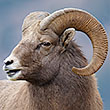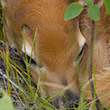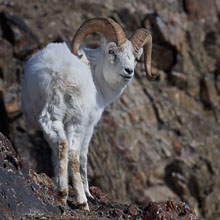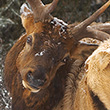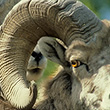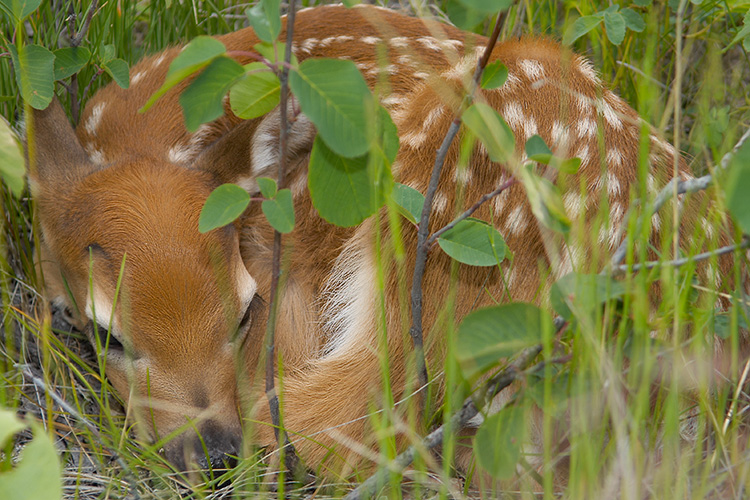
Availability: Undetermined - Enquiries?
In the Field
Fawn & Foliage. Findlay Creek, BC, Canada. June 13, 2006.
Every year a number of White-tailed and Mule Deer, as well as Elk, calve (give birth) on our property. I often literally stumble over the fawns/calves, and it's normally when I least expect it. About the only thing I can count on is that I'm most likely to stumble onto one when I'm NOT carrying a camera!
When I encountered this white-tail fawn I was really lucky - I had a camera with me. My cardinal rule when I stumble upon these little bambis is to leave the scene as rapidly as possible. In this case I quickly changed lenses, threw on a flash unit (it was overcast with light rain beginning), and grabbed an exceptionally quick snapshot and left. I didn't even check the exposure or grab multiple shots. The resultant image is acceptable, but shows the effects of haste. There are some pretty unnatural shadows (produced by the flash and leaves), but at least when I look at the image I know that I didn't place the fawn under any undue stress or danger. And that's the ultimate cardinal rule of wildlife photography: ALWAYS minimize your impact on your subject and ALWAYS place your subject's welfare ahead of your photography.
Behind the Camera
Fawn & Foliage. Findlay Creek, BC, Canada. June 13, 2006.
Digital Capture; Compressed RAW (NEF) format; ISO 100.
Nikon D2X with Nikon 17-55 mm f/2.8 DX G ED-IF AF-S lens @ 55 mm (82 mm equivalent with digital conversion factor) - handheld. SB-800 flash (for fill) mounted on camera.
1/80s @ f4.5; -1.0 stop compensation from matrix-metered exposure setting; flash (in i-TTL mode) with no flash exposure compensation.
At the Computer
Fawn & Foliage. Findlay Creek, BC, Canada. June 13, 2006.
RAW Conversion to 16-bit TIFF, including first-pass sharpening and tone curve adjustment, using Phase One's C1 Pro.
All further digital correction on 16-bit TIFF file using Adobe's Photoshop CS2, including selective saturation enhancement and selective sharpening for web output.
Conservation
Fawn & Foliage. Findlay Creek, BC, Canada. June 13, 2006.
Species Status in Canada*: This species is not designated as at risk.
White-tailed Deer (Odocoileus virginianus) are one of the most widely distributed mammals in North America - they can be found in virtually all of southern Canada and in most of the American states. While whitetails are common now, in the late 1800's they were in serious risk of extinction - their populations had been reduced from about 40 million (across North America) to under 500,000. The conservation effort to return whitetails to numbers sufficient for long-term survival was massive and included strict harvest regulations, intense management, reintroductions, and habitat protection. Today, most populations in the United States do not represent original stock and the distinction of most historical subspecies is uncertain.
Whitetails resemble Mule Deer quite closely, and the two species overlap in distribution in western North America. The two species tend to prefer different habitats, with whitetails occupying more heavily forested land and along river valley bottoms, while muleys tend to prefer uplands and montane areas. On rare occasions, the two species will interbreed. Occasionally the offspring are fertile, but in most cases they are sterile.
This whitetail fawn was photographed in the Columbia Valley of the East Kootenays. While this species is not currently considered at risk, many ecosystems within the Columbia Valley face development pressure, including pressure from logging operations.
*as determined by COSEWIC: The Committee on the Status of Endangered Wildlife in Canada


















